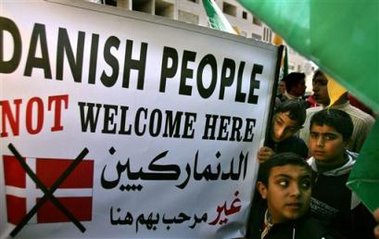 Palestinian children hold an anti Danish banner during a joint Hamas and Fatah movement demonstration to protest against caricatures of Islam's prophet Muhammad in the West Bank town of Aram, just outside Jerusalem, Tuesday, Feb. 7, 2006. Hundreds of Hamas and Fatah Party protesters turned out in Aram to burn Danish flags and call for a boycott of Danish products. (AP Photo/Muhammed Muheisen)
Palestinian children hold an anti Danish banner during a joint Hamas and Fatah movement demonstration to protest against caricatures of Islam's prophet Muhammad in the West Bank town of Aram, just outside Jerusalem, Tuesday, Feb. 7, 2006. Hundreds of Hamas and Fatah Party protesters turned out in Aram to burn Danish flags and call for a boycott of Danish products. (AP Photo/Muhammed Muheisen)I've been watching this situation with the Muslim cartoon outrage with some sort of disconnect from reality. I"m not sure what to say, or comment about both the publication of the cartoons--one depicting the Prophet Muhammad wearing a turbin shaped like a bomb--in Danish and Norwegian publications, or the widespread protests within the Middle East, culminating in the burnings of both the Danish and Norwegian embassies in Lebanon, Syria, Iran, and with the violence spreading into Afghanistan. This is from Yahoo News:
KABUL, Afghanistan - NATO peacekeepers exchanged gunfire with protesters who attacked their base Tuesday in another day of deadly demonstrations in
Afghanistan over the publication of caricatures of the Prophet Muhammad, officials said. Three demonstrators were killed.An Afghan police officer beats a protester outside the Danish embassy during a protest demonstration in Kabul on Tuesday. (AP Photo/Rafiq Maqbool)
In neighboring Pakistan, 5,000 people chanting "Hang the man who insulted the prophet!" burned effigies of Denmark's prime minister and a cartoonist.Pakistani protesters hold placards as they shout slogans on a street during a protest rally in Peshawar. Violent protests against caricatures of the Prophet Mohammed escalated, with four demonstrators killed during an attack on NATO troops in Afghanistan and a renewed assault against the Danish embassy in Tehran.(AFP/Tariq Mahmood)
Denmark Prime Minister Anders Fogh Rasmussen called the protests "a growing global crisis" and appealed for calm. The Danish paper Jyllands-Posten was the first to publish the drawings, in September.
"It now is something else than the drawings in Jyllands-Posten," he said. "Now it has become an international political matter."
A prominent Iranian newspaper said it was going to hold a competition for cartoons on the Holocaust in reaction to European newspapers recently republishing the prophet drawings. Iran's supreme leader, Ayatollah Ali Khamenei, said the Muhammad drawings were an Israeli conspiracy motivated by anger over the victory of the militant Hamas group in last month's Palestinian elections.
The European Union, in turn, warned Iran that attempts to boycott Danish goods or cancel trade contracts with European countries would lead to a further deterioration in relations. Those relations already are strained by concerns over Iran's nuclear program.
President Bush called Fogh Rasmussen to express "solidarity and support" in the wake of the violence, the White House said Tuesday. Spokesman Scott McClellan said the leaders agreed that all sides must move forward "through dialogue and tolerance, not violence."
About 50 protesters hurled stones and firebombs at the Norwegian Embassy in Tehran. A small fire outside the embassy was quickly contained.Protesters run after police used tear gas in front of the Danish embassy in Tehran, on Monday Feb. 6, 2006. Police used tear gas to disperse hundreds of angry protesters who hurled stones and fire bombs at the Danish Embassy in the second attack on a Western embassy in the Iranian capital Monday over the publication of caricatures of the Prophet Muhammad. Police had encircled the embassy building but were unable to hold back the mob of 400 demonstrators as they pelted the walled brick villa housing the Danish mission with stones and Molotov cocktails. (AP Photo/Hasan Sarbakhshian)
The drawings--including one depicting the prophet wearing a turban shaped as a bomb-- have touched a raw nerve partly because Islam is interpreted to forbid any illustrations of Muhammad for fear they could lead to idolatry.
The most violent demonstrations were in Afghanistan, where thousands of rioters clashed with police and NATO peacekeepers across the country.
About 250 protesters armed with assault rifles and grenades attacked the NATO base in the northwestern town of Maymana, burning an armored vehicle, a U.N. car and guard posts, said a Maymana Hospital doctor.
Some in the crowd fired light weapons and threw stones and hand grenades, and the Norwegian troops responded with tear gas, rubber bullets and warning shots, said Sverre Diesen, commander of Norwegian forces.
Three protesters were shot to death and 25 others were wounded, while some 50 others were hurt by tear gas fired by the peacekeepers, said Sayed Aslam Ziaratia, the provincial deputy police chief.
Seven NATO soldiers were hurt, Diesen told reporters in Oslo.
It was not clear who killed the protesters.
There is more regarding the violence that is spreading, but I'm not going to comment on it--you can pretty much get the picture that has become a complete and utter mess.
But there's a larger issue here, that no one really wants to talk about. It is the issue regarding freedom of the press, and what this freedom means in both the western countries of the Denmark, Norway, the United States, and other countries that make up "the West," in comparison to what freedom of the press means to countries in the Middle East. The western countries of Europe, the U.S., Canada, and other similar nations, have been able to disconnect the issue of religion, from government. They have been able to place religion within the context of the individual, where the individual can worship God in his or her own way--without government supervision or interference. Laws are created for the benefit of all society--not for the benefit of a particular religious belief or ideology. It may not be a perfect system, but it has worked to the benefit of Western civilization to grow, economically, and culturally. This disconnection has also allowed the press to express alternative views, ideas, and criticisms--just as the individual can express such views with their own rights of free speech, and protest. I have a right to publish my own ideas, criticisms, and opinions on various issues--including religion. And while my ideas may offend some people who live in the U.S., they have a right to respond to my criticisms with their own criticisms. Thus we have the start of a debate on an issue. Remember Piss Christ? It was a controversial photo by Andres Serrano, which depicted a small crucifix submerged in a glass of the artist's urine. The picture created a lot of controversy among fundamentalists, when it was discovered that Serrano recieved support from the National Endowment for the Arts to publish his art in 1987. The fundamentalists wanted to censor Serrano's artwork, and even shut down government funding for the National Endowment for the Arts, for exhibiting such artwork. What is important here, is that Serrano was able to express his ideas regarding religion through this controversial piece. It generated a buzz, and debate on the issue of Christianity, and Jesus Christ's relationship with man. This freedom also allows individuals to express their own political, or even racial ideologies--if you believe what the Klu Klux Klan, or the American Nazi Party expresses with their ideology, you have that right to publish, or express that ideology. The rest of American may not like what you say, but we will tolerate the expression of your ideology for the benefit of allowing all of American society's freedom of expression through speech, protest, and press.
 Andres Serrano's Piss Christ
Andres Serrano's Piss Christ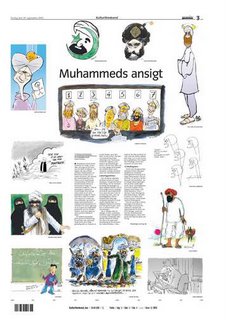 Jyllands-Posten Muhammad drawings
Jyllands-Posten Muhammad drawingsAs for the Middle East, I don't the Muslim world can really understand this freedom of expression, and press. The Muslim world has not been able to disconnect religious ideology from society as a whole, or from government. Islam is an integrated part of the Muslim world. Here in the United States, we have the individual right to worship--or not to worship--God as we please. Religion is integrated within the individual. In the Muslim world, it is completely opposite, where the Islamic religion is integrated within society, and individuals worship the Prophet Muhammad through society as a whole. Islamic law is incorporated throughout the Muslim world--to remove the religious law from Muslim society, could destroy such society. It's leaders in the Muslim governments are religious scholars, and powerful clerics. The so-called "secular" governments--such as Saudi Arabia, Jordan, or perhaps Syria-- may have a secular government controlling the respected countries, but their societies are still deeply embedded, both religiously and culturally, to the Islamic religion. And considering that it is forbidden to depict any images of God, or the Prophet Muhammad within Islamic religion, and Muslim society as a whole, it is impossible for the average Muslim to understand our western views of separating religion from government, society, and the freedoms of expression in speech and the press. Thus, a cartoon depicting a Prophet Muhammad with a bomb-shaped turbin becomes an attack on Muslim society as a whole.
I have no clue as to how to resolve such a controversy. The problem here is a class between two civilizations--where one civilization has taken religion out of society as a whole, and incorporated it within the individual, while the other society still incorporates religion within the whole of that society. The difference within this ideology between both civilizations are divided so far apart, that it is difficult to reach a consensus or compromise on the issue.
More to come.
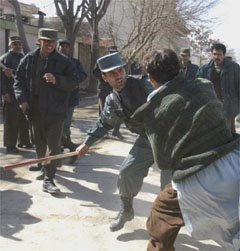
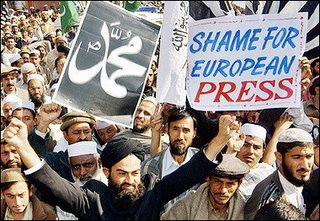
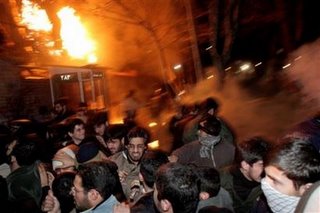
No comments:
Post a Comment